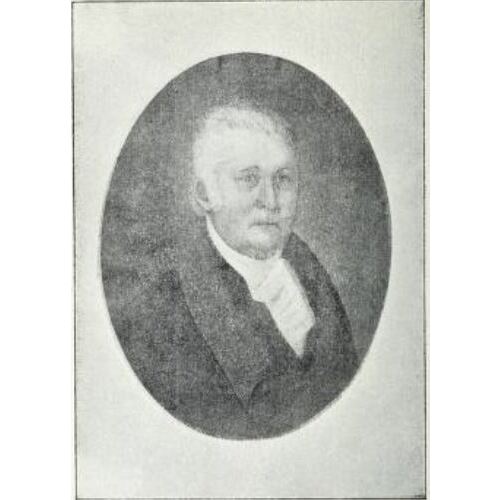
Source: Link
RIDOUT, THOMAS, office holder; b. 17 March 1754 in Sherborne, Dorset, England, son of George Ridout; m. first c. 1776 Isabella –,and they had one son, Samuel Smith*; m. secondly 26 May 1789 Mary Campbell, and they had seven sons, including George* and Thomas Gibbs*, and five daughters; d. 8 Feb. 1829 in York (Toronto), Upper Canada.
In 1774 Thomas Ridout emigrated to Maryland where an elder brother, already established as a government official at Annapolis, financed his entry into the carrying trade with the West Indies and France. By concentrating upon his commercial affairs, Thomas seems to have avoided the crisis of conscience posed by the revolution to many Americans, especially recent arrivals from Britain. At the end of the revolutionary war, during which he had continued his Atlantic trading activities, he was viewed as a friend and supporter of the new American nation.
In 1787, however, Ridout took a journey westward that would change his future and his allegiance. He set out in December 1787 for the new settlement of Kentucky. His ostensible purpose was to collect some business debts, but he also carried letters of introduction, one from no less a personage than George Washington, indicating that he went “to explore and perhaps to settle” there. His original plans, whatever they were, collapsed when he and a small band of travellers were captured by Shawnee Indians in March 1788 on the Ohio River. Unlike several of his companions Ridout escaped death and, after three months’ captivity, was taken to British-held Detroit and freedom.
By mid July Ridout was at Montreal. He arrived there just as Lord Dorchester [Guy Carleton*] was erecting four new judicial districts in western Quebec. The possibility of establishing a separate western colony was being discussed and Ridout may have been influenced to stay by the positive reception he was accorded and by the chance of employment in the new jurisdiction. In May 1789 he married the daughter of a loyalist and by the end of the year was contemplating permanent residence in British North America. In 1792 he obtained a position in the commissariat and with his young family moved to Newark (Niagara-on-the-Lake) to join the new administration being set up there by Upper Canada’s first lieutenant governor, John Graves Simcoe*.
In 1793 Ridout entered the surveyor general’s office as first clerk. Despite this modest beginning and competition from deputy surveyor general William Chewett*, who was better trained and more professionally active, Ridout soon rose in the department. He and Chewett acted jointly as surveyors general in 1799, 1802, and 1807 during the absences of the regular incumbents. In the latter year Ridout succeeded in avoiding involvement in the dispute between Lieutenant Governor Francis Gore* and Surveyor General Charles Burton Wyatt*. Gore suspended Wyatt and, albeit temporarily, Ridout’s eldest son, a deputy provincial surveyor. In the fall of 1809, after two years of acting as joint department head, Ridout travelled to England with Gore’s support to lobby for the surveyor generalship. He was successful and officially received the appointment in September 1810, retaining the post until his death.
Ridout’s rising stature in the young society is probably better mirrored in his activities outside the department. He was made registrar of York County in 1796, a year before moving to the new capital, sergeant-at-arms to the House of Assembly in 1798, and clerk of the peace for the Home District in 1800.
Ridout was elected in 1812 to the assembly for the East Riding of York and Simcoe, defeating Joseph Shepard* who, in Ridout’s words, represented the “Democratic Faction” and was supported by Joseph Willcocks*. Ridout did not run in 1816 and his son George, a moderate loosely aligned with William Warren Baldwin*, lost the seat to Peter Robinson*. Ridout did not campaign for office again but he was called to the Legislative Council in 1825 and served until his death.
Ridout was rather old to take an active role in the War of 1812 but he supported his sons in their various endeavours and himself became a director of the Loyal and Patriotic Society of Upper Canada. A decade later he was appointed to the board established to review claims for war losses. In 1822 he became a member of the Clergy Reserves Corporation and in 1827 he was appointed to the original board of King’s College (University of Toronto), thus joining initiatives of John Strachan* on behalf of the Church of England.
Ridout worked assiduously to establish himself in the new colony. By dint of perseverance and steady application he secured a niche for himself and his family, especially sons George and Thomas Gibbs, in the developing administration and society of Upper Canada. Though he saw himself as a man of independent mind, a characteristic more frequently displayed by his offspring, he was in reality one of many middle and minor functionaries upon whose steady support and conservative views rested the growing power of the colonial oligarchy which has come to be known as the “family compact.”
AO,
Cite This Article
Robert J. Burns, “RIDOUT, THOMAS,” in Dictionary of Canadian Biography, vol. 6, University of Toronto/Université Laval, 2003–, accessed December 16, 2025, https://www.biographi.ca/en/bio/ridout_thomas_6E.html.
The citation above shows the format for footnotes and endnotes according to the Chicago manual of style (16th edition). Information to be used in other citation formats:
| Permalink: | https://www.biographi.ca/en/bio/ridout_thomas_6E.html |
| Author of Article: | Robert J. Burns |
| Title of Article: | RIDOUT, THOMAS |
| Publication Name: | Dictionary of Canadian Biography, vol. 6 |
| Publisher: | University of Toronto/Université Laval |
| Year of publication: | 1987 |
| Year of revision: | 1987 |
| Access Date: | December 16, 2025 |



